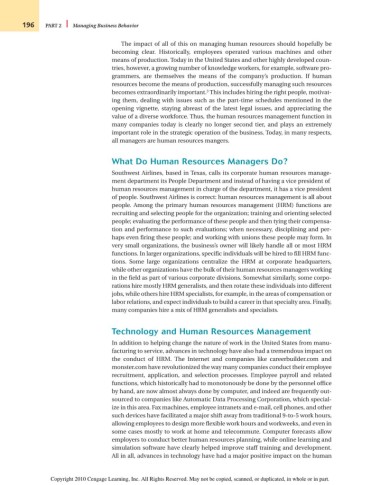Page 222 - Introduction to Business
P. 222
196 PART 2 Managing Business Behavior
The impact of all of this on managing human resources should hopefully be
becoming clear. Historically, employees operated various machines and other
means of production. Today in the United States and other highly developed coun-
tries, however, a growing number of knowledge workers, for example, software pro-
grammers, are themselves the means of the company’s production. If human
resources become the means of production, successfully managing such resources
3
becomes extraordinarily important. This includes hiring the right people, motivat-
ing them, dealing with issues such as the part-time schedules mentioned in the
opening vignette, staying abreast of the latest legal issues, and appreciating the
value of a diverse workforce. Thus, the human resources management function in
many companies today is clearly no longer second tier, and plays an extremely
important role in the strategic operation of the business. Today, in many respects,
all managers are human resources mangers.
What Do Human Resources Managers Do?
Southwest Airlines, based in Texas, calls its corporate human resources manage-
ment department its People Department and instead of having a vice president of
human resources management in charge of the department, it has a vice president
of people. Southwest Airlines is correct: human resources management is all about
people. Among the primary human resources management (HRM) functions are
recruiting and selecting people for the organization; training and orienting selected
people; evaluating the performance of these people and then tying their compensa-
tion and performance to such evaluations; when necessary, disciplining and per-
haps even firing these people; and working with unions these people may form. In
very small organizations, the business’s owner will likely handle all or most HRM
functions. In larger organizations, specific individuals will be hired to fill HRM func-
tions. Some large organizations centralize the HRM at corporate headquarters,
while other organizations have the bulk of their human resources managers working
in the field as part of various corporate divisions. Somewhat similarly, some corpo-
rations hire mostly HRM generalists, and then rotate these individuals into different
jobs, while others hire HRM specialists, for example, in the areas of compensation or
labor relations, and expect individuals to build a career in that specialty area. Finally,
many companies hire a mix of HRM generalists and specialists.
Technology and Human Resources Management
In addition to helping change the nature of work in the United States from manu-
facturing to service, advances in technology have also had a tremendous impact on
the conduct of HRM. The Internet and companies like careerbuilder.com and
monster.com have revolutionized the way many companies conduct their employee
recruitment, application, and selection processes. Employee payroll and related
functions, which historically had to monotonously be done by the personnel office
by hand, are now almost always done by computer, and indeed are frequently out-
sourced to companies like Automatic Data Processing Corporation, which special-
ize in this area. Fax machines, employee intranets and e-mail, cell phones, and other
such devices have facilitated a major shift away from traditional 9-to-5 work hours,
allowing employees to design more flexible work hours and workweeks, and even in
some cases mostly to work at home and telecommute. Computer forecasts allow
employers to conduct better human resources planning, while online learning and
simulation software have clearly helped improve staff training and development.
All in all, advances in technology have had a major positive impact on the human
Copyright 2010 Cengage Learning, Inc. All Rights Reserved. May not be copied, scanned, or duplicated, in whole or in part.

